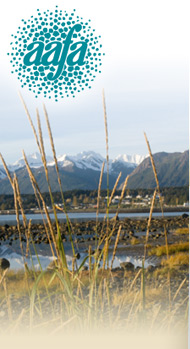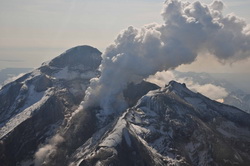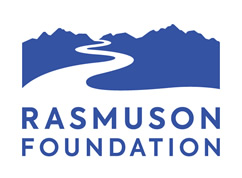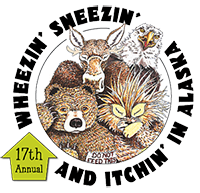
- Donate Online Now
- Become a Website Sponsor
- e-Newsletter Sign-up
- Request a Speaker
 Join us on Facebook
Join us on Facebook
Volcano Awareness
 Alaska sits on the “ring of fire”. With 44 historically active volcanoes there is always
potential for one to awaken and threaten eruption. Mount Redoubt has been rumbling and
simmering since January 25, 2009. This activity has caused its aviation status to be upgraded
from yellow to orange. Redoubt’s last major eruption occurred in 1989. Within 23 hours it
went from background seismic activity to full eruption- very rapid for a volcano. The
resulting ash cloud nearly brought down a KLM passenger jet. The three most active Cook
Inlet volcanoes over the past 50 years are Augustine Volcano, Mount Spurr and Mount
Redoubt- all within 200 miles of anchorage, the most populous city in Alaska. Volcanic
blasts spew hot dangerous gases, ash, lava and rock. These cause immediate destruction in
the local area. Ice and snow are melted causing super heated mudslides (lahars) and flood
surges leading to damage of anything in their path.
Alaska sits on the “ring of fire”. With 44 historically active volcanoes there is always
potential for one to awaken and threaten eruption. Mount Redoubt has been rumbling and
simmering since January 25, 2009. This activity has caused its aviation status to be upgraded
from yellow to orange. Redoubt’s last major eruption occurred in 1989. Within 23 hours it
went from background seismic activity to full eruption- very rapid for a volcano. The
resulting ash cloud nearly brought down a KLM passenger jet. The three most active Cook
Inlet volcanoes over the past 50 years are Augustine Volcano, Mount Spurr and Mount
Redoubt- all within 200 miles of anchorage, the most populous city in Alaska. Volcanic
blasts spew hot dangerous gases, ash, lava and rock. These cause immediate destruction in
the local area. Ice and snow are melted causing super heated mudslides (lahars) and flood
surges leading to damage of anything in their path.
Health concerns
Heavy ash fall can cause collapse of roofs- crushing occupants. Inhalation of hot coarse ash particles can cause burns and asphyxiation. Inhalation of respirable ash particles (<10 microns in diameter) may be more problematic. Historical data suggests short term exposures to ash do not cause significant health hazards. Long term health effects need further study. Regardless, people should avoid unnecessary exposure to ash, especially people with chronic respiratory disorders- asthma, emphysema, and chronic bronchitis. Adverse health effects typically involve the respiratory tract, eyes and skin. Ash may contain free crystalline silica which is known to cause silicosis- usually found in miners and quarry workers who have been exposed to high concentrations of siliceous dust over long periods of time. In volcano eruptions the exposure to respirable sized free crystalline silica is typically short duration- days to weeks. Recommended respirable exposure limit is 50 micrograms per cubic millimeter of air. There are no documented cases of silicosis attributed to free crystalline silica in volcanic ash. Other factors to consider in any potential effects of ash exposure include airborne concentration of total particles, proportion of respirable particles (<10 microns), frequency and duration of exposure, presence of free crystalline silica, volcanic gases or aerosols, weather conditions and factors existing in the individual and use of protective gear (respiratory protective equipment). Upper and lower respiratory complaints have included nasal and throat irritation, increased rhinitis, cough and increased asthma symptoms. Eye complaints are typical. Volcanic ash is abrasive and as a foreign body in the eye can cause corneal abrasions. Skin irritation is sometimes reported. Driving in ashy conditions may be challenging due to slippery road conditions and poor visibility. Volcanic gases typically blow away rapidly. It is possible that people close to the volcano or in low lying areas down wind may be exposed to levels that affect health. Carbon dioxide and hydrogen sulfide may collect in low lying areas. The most common volcanic gas is water vapor, next most common are carbon dioxide and sulfur dioxide. These can cause breathing difficulties in healthy individuals as well as those with chronic respiratory conditions. The amounts and types of gases vary widely from one volcanic eruption to the next. At low levels these gases tend to be irritants to the eyes, nose and throat. At higher levels respiratory difficulties, headache, dizziness and suffocation can occur.
How to protect yourself
Be aware of volcanic activity. Avoid unnecessary exposure. Wear an effective face mask when outside and involved with cleanup operations. Patients with chronic respiratory diseases should stay inside and avoid unnecessary exposure to ash. Handle ash in open, well ventilated areas and wet the dust when possible to minimize its movement. Wear goggles or glasses instead of contacts especially in fine ash environments. Keep doors and windows closed. Keep kids indoors when ash is visible. Avoid strenuous play or exercise when ash is in the air. Clean indoors more frequently to minimize indoor ash exposure. Very simple measures can help prevent significant irritation.
Annual Conference
Today's Pollen Count
Anchorage pollen counts aided by a grant from the Rasmuson Foundation





